|
|
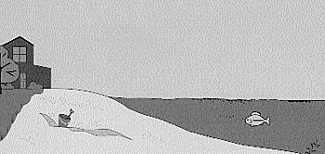 |
 |
Used with permission of the Minnesota Department of Natural Resources. | |
|
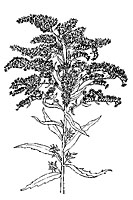 Solidago species goldenrod prairie |
Sustainable Landscapes Increase Biodiversity
|
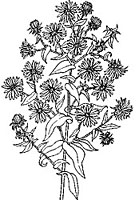 Aster Novae-anglia New England aster prairie |
|
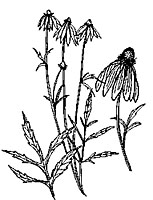 Ratabida pinnata gray-headed coneflower prairie |
Considerations for Sustainable Landscape DesignWhen designing a sustainable lakeside landscape, information is needed about the lot and adjacent lakeshore, including water runoff patterns, so that erosion can be prevented and water quality improved. Microhabitats must be identified so that suitable plants can be chosen and adequate numbers of plants can be grown or ordered. The ordinary high water level of the lake must be determined since MN DNR regulations apply to areas below this level. All this information can be organized and summarized into a plan based on your needs and preferred property uses. If desired, a landscape design firm can help develop plans.The MN DNR has an excellent book on landscaping entitled "Lakescaping for Wildlife and Water Quality", by Carrol L. Henderson, Carolyn J. Dindorf, and Fred J.Rozumalski, 1998, MN DNR, Section of Wildlife, Nongame Wildlife Program. Order by calling the Gift Shop at 651 228-9165 or Minnesota's Bookstore 651-297-3000. |
 Veronicastrum verginicum Culver's root prairie |
|
Site aspects: Planning to complement activities Landscape to complement your activities. For example, if a large lawn is not needed, parts of the lawn can be replaced with ground covers, perennials or shrubs. Note areas where views may be enhanced or screened with vegetation. Do not disturb areas with natural vegetation. Plan to install bird feeders and bird houses and benches to sit on to enjoy the view. Accessories in the landscape are signs of a cared for and well-managed property. These elements of care show neighbors that the property is not neglected and are especially valuable in unconventional landscapes.
Site aspects: Identify any erosion problems
Site aspects: Identify microhabitats or zones Select plants which are suitable for the location based on observations of soil moisture and sunny or shady conditions. Recommended species are listed in Table 1 and the more extensive native plant list at the end of the bulletin. Trees and shrubs will provide shade, frame your view, and hold soils on steep slopes. Grasses, sedges and flowering perennials can be used where an unobscured view is important.
Site aspects: Selecting plants
Site aspects: Use a buffer strip of vegetation
Site aspects: Identify the lake boundary |
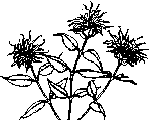 Monarda fistulosa wild bergamot prairie
|
|
Implementing: Obtaining plants and seeds As native plant landscaping becomes more and more popular, more nurseries are propagating and selling native plants, locally or by mail. It is best to buy plants that are propagated from plants native to Minnesota. Although it is tempting, do not remove plants from the wild unless you have a permit. Plants can be raised from seed. Seeds may be purchased from suppliers, or collected on private property with the landowner's permission, as long as this can be done without harming wild populations. Seeds from endangered, threatened, or special concern species must not be collected. These species are not included on the plant list. Most seeds of native plants require a cold treatment before they will germinate. Mix the seeds with damp sand and refrigerate them for two months. Or seeds can be planted in pots in the fall, covered with mulch, and left outdoors in a protected, shaded spot or unheated garage, for the entire winter. Uncover the pots in spring and keep them watered. |
In the Twin Cities area, native vegetation included oak savanna on the uplands with wet prairie grading into wetlands in the valleys. The native plants supported animals and people. Many plants were used in historic times as foods, medicines, dye plants, building materials and craft materials. Preserve our native plants by using them in landscapes and large scale revegetation projects. |
|
Implementing: Planting prairie, woodland and wet meadow Remove existing vegetation before planting to increase success. Existing plant roots can compete with tender young roots of newly planted vegetation. Sod and weeds can be removed by hand, by rototilling, or by covering them with plywood and/or black plastic sheets for two months or more. In areas that are rototilled, care must be taken to prevent erosion and reduce runoff. Alternatively, herbicides can also be used. Do not allow herbicides to enter the water. If herbicides have been used, wait two weeks before planting. Areas which are overgrown with reed canary grass, purple loosestrife, or cattails are difficult to plant due to the intense competition from these weeds. These plants may be removed mechanically or with the use of herbicides. It is best to plant on a drizzly or overcast day. Planting tips include:
|

Pontederia cordata |
| For plantings, one plant per square foot is recommended, but dense plantings will cover the ground faster, especially on slopes. Three years may be needed for some plants to mature. Most plants are slow-growing at first as they develop roots, so small transplants yield more rapid results than direct seeding. Direct seeding of prairie and wet meadow plants may be used to cover large areas. Spring and fall are the best times for seeding in Minnesota. Broadcast seed by hand or use a spreader on prepared soil. Ensure good seed-to-soil contact by lightly raking the seed in, then rolling with a lawn roller. Cover the seeded area with a light mulch of weed-free straw. |
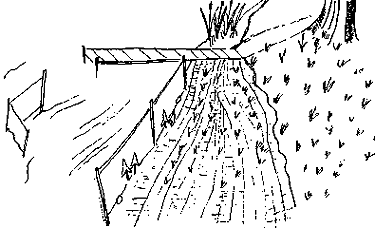
Newly planted buffer strip
along a lake margin with wavebreaks and silt fence. |
|
Implementing: Planting the emergent and submergent zone All aquatic areas of lakes and areas below the ordinary high water level are regulated by the Minnesota Department of Natural Resources. A permit is required to plant or remove vegetation, to use herbicides, and to install wavebreak structures. Revegetation in the emergent and submergent zones is not as well researched as prairie plantings. Prevent sediment from entering water by placing straw bales or filter fences between the planting area and water. Undesired vegetation in the emergent zone can be removed by hand or by heavy mulching with plywood or black plastic left in place for two months before planting. Wetland soils should not be tilled. Herbicide use is not recommended and requires DNR approval. Areas with heavy wave action, whether natural or due to boat traffic, may require wavebreaks such as brush bundles, coconut fiber logs, or plywood held in place with a PVC frame so plants will not be washed away before the plants take root. Plants can be planted directly into coconut fiber logs or biodegradable erosion mats. See the list of suppliers at the end of this bulletin. Remember different bottom sediments influence wave action. Area with sandy bottoms often have higher wave action, which could be reduced if aquatic plants colonized the area. |
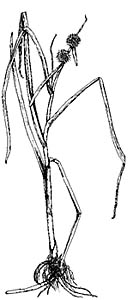
Sparganium americanum |
|
We recommend using plants, rhizomes (underground stems with buds), or tubers
rather than seeds, in the emergent and submergent zones. Seeds of most emergent
plants will not germinate under water, so unless the water level can be controlled,
you must wait for a dry period to plant them.
Plants for emergent and submergent zones should be planted as soon as possible after you receive them. Keep them cool and moist. Emergent plants must have some of their leaves above the water in order to start growth, although they may spread into deeper waters later. Do not clip or prune them. Tubers of arrowhead, bulrushes, and waterlillies need to be planted by pushing the tubers firmly into the mud or sand. Plants, tubers, and rootstocks may be held in place by staking them down, tying them to bricks using cotton string, or placing them in cheesecloth bags weighted with rocks. Some suppliers sell tubers, rhizomes, or plants with weights attached. These can be dropped directly into the water in areas protected from wave action. As roots develop, plants will be held in place. |
To plant or remove aquatic vegetation, contact the DNR office nearest you or the
Ecological Services Section |
|
Maintenance: Long-term sustainable management Watering may be necessary during the first season after planting, even in areas close to the lake. The native plants will out compete the weeds gradually, but it is best to remove as many weeds as possible by hand before they develop deep roots. Prairie restorations may be mowed or burned in fall or spring to prevent invasion of trees and exotic grasses, but check local ordinances and the MN DNR, as burning requires a permit. Do not burn for the first three years after planting. Once the restoration is well established, burning every three years will maintain it. In urban areas where burning is prohibited, mowing in early spring can mimic fire conditions.
The components of sustainable management are
Maintenance: Use plants suitable to the microhabitat
Maintenance: Low input lawn care
Maintenance: Composting
Maintenance: Integrated Pest Management (IPM)
Maintenance: Appreciate the sustainable landscape |
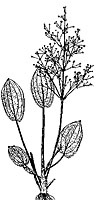
Alisma plantago-aquatica
Sagitaria latifolia
Typha latifolia |
Some beneficial insects
|

Nymphaea odorata |
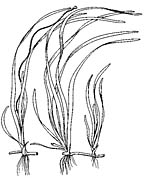
Valisneria americana |
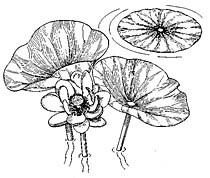
Nelumbo lutea |
| References and Further Resources Related Websites Native Plant List |
Gervais Lake Shoreland Project |
 |
(C) Regents of the University of
Minnesota. All rights reserved. |
 |
 |